European Galleries, 1850-1900, Philadelphia Museum of Art, Philadelphia
Reviewed by Cordula GreweCordula Grewe
Professor of Art History, Indiana University Bloomington
Email the author: cgrewe[at]iu.edu
Citation: Cordula Grewe, installation review of European Galleries, 1850-1900, Philadelphia Museum of Art, Philadelphia, Nineteenth-Century Art Worldwide 21, no. 3 (Autumn 2022), https://doi.org/10.29411/ncaw.2022.21.3.10.
This work is licensed under a Creative Commons Attribution-NonCommercial 4.0 International License  unless otherwise noted.
unless otherwise noted.
Your browser will either open the file, download it to a folder, or display a dialog with options.
In 1928, Philadelphia could celebrate the completion of its most ambitious museum building to date. A consummate example of the City Beautiful Movement of the 1890s, it was perched high above the city as a true temple of art. Its east facade looked over the Parkway, imagined as Philadelphia’s Champs-Elysée; to the west was the Schuylkill River, where Frederick Graff’s acclaimed waterworks, built between 1812 and 1872, completed the site’s neo-Grec evocation of an ancient acropolis. Today, entering the building from the side facing the river, we are greeted by the solemn monumentality of the grand staircase and an iridescent Diana (1892–93), who, about to release her bow, is aiming at an invisible victim hiding somewhere on the third-floor balcony. Once she stood high in the open air, crowning the tower of Madison Square Garden as a major artistic feature of New York’s skyline. Now, still poised elegantly atop an orb, the former weathervane shimmers temptingly against the stony background of the building’s dolomitic limestone, her gold-leaf finish restored to its former glory in 2013–14. The lithe goddess is a perfect preamble to the newly renovated and reinstalled galleries of European art from between 1850 and 1900 that branch off at the bottom of staircase to the right.
The first room (Gallery 250), an intimate space of merely 16 x 15 feet, sets the tone for much of what follows (fig. 1). Leaving behind the cold grandeur of the entrance hall, a charming ensemble transports us into a magic world of color and décor. It is almost as if an eternal spring has settled into the cozy room, and, feeling an almost visceral sense of well-being, we soak in the sun and sweet morning air that Louis-Joseph Raphaël Collin, enchanted by the fashionable woman in the open window, recorded with such panache in 1884 (fig. 2). It is a dreamy slice of life, which the curator in charge of the overhaul, Jennifer Thompson, has chosen to welcome us, a celebration of color and ornamental beauty, orchestrated around an abundance of flowers, flowers growing in the front yard, gathered into a wild bouquet, and placed rather precariously on the window sill, with still more flowers lurking in even thicker, larger arrangements in the room’s dark interior, flowers piled up high on the hat of the young woman at the window or strewn, as little colorful dots, across the white cotton of her tightly tailored dress. Only her introspective expression seems at odds with the scene’s vivacious fecundity, and we wonder whether she feels uneasy about appearing as yet another ornament. Such feminist sentiment is certainly reinforced by the vignettes of modern life facing her (fig. 3). Compared to the leisurely airiness of Collin’s canvas, the image of a woman ironing, portrayed by François Bonvin in 1858, is decidedly gloomy both in effect and theme, and its bold depiction of the taxing nature of domestic labor resonates strongly with the smoking chimneys lining the Thames in Jules Bastien-Lepage’s 1882 London. Our initial feeling of carefree enjoyment yields to a more somber contemplation of inequality, as the pictures pitch leisure against labor; we begin to wonder about the role of gender and class in determining a nineteenth-century life. Until that moment, however, we are simply filled with the room’s floral magic, a magic not only performed by Collin’s sizable canvas but also by two gargantuan porcelain vases that once, as the historic photo on the accompanying label demonstrates, carried equally oversized, equally ornate candleholders. A rather large sign reminds us not to touch these elegant vessels, produced in 1862 by Sèvres, and rightfully so, for the haptic allure of the finely worked surfaces with their raised designs of flowers, musical instruments, and even legible scores seem all too enticing (fig. 4). How might these cool surfaces and layers of pâte-sur-pâte (a relief design created with layers of liquid clay) feel if touched? Hopefully, we will not surrender to the temptation to find out.
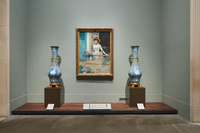
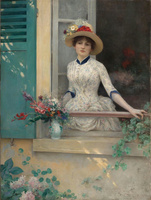
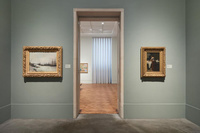
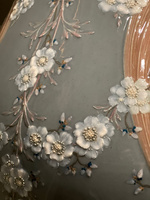
Although the first of seventeen rooms dedicated to the museum’s European holdings between the revolutions of 1848 and the fin de siècle is hardly noteworthy in size, it partakes in the engaging and ultimately quite radical rethinking of how to display this part of the permanent collection, which ranges from new lighting to the programmatic combination of applied and fine arts across a wide array of mediums. The replacement of the uniform beige so en vogue at the time of the last reinstallment in 1993 is more than a facelift. The broad range of hues—chosen with an eye to the original historic colors—brings out the paintings’ palettes, allowing them, no longer overpowered by the harshness of the white cube, to breathe in their full coloristic intricacies. It also congenially marries modern viewing expectations with original display practices. This sensitive and most satisfying approach continues in the choice to group pictures, by popular and lesser-known artists alike, in multi-layered arrangements rather than reducing them to a line-up of the most wanted suspects. I will come back to this again later on. For now, I want to note that the carefully curated wall colors also bestow a new coherence on the works’ conversation across time and space, while adding tremendously to the rooms’ atmospheric qualities. The beautifully subtle and soothing color of the paint on the walls of the first gallery (made by Benjamin Moore and called “Vapor Trails”) is a striking case in point. At the same time, the use of dramatic spotlights, instead of the previous imitation of natural light from above, suggests that each work is worthy of attention. Last but not least, the reinstallation takes great care to create sophisticated dialogues between art and objects which might be similar or decidedly different, actualizing the important lesson learned from the pioneers of art history (and the scientists that inspired them): that we see more if we compare and contrast, weighing one specimen against another. Nothing demonstrates the truth of this old insight with more aesthetic vigor than the next gallery, which opens immediately to the right (Gallery 251) and greets us with complex, albeit often unequal encounters between East and West, between France and Great Britain, on the one hand, and Japan and China, on the other.
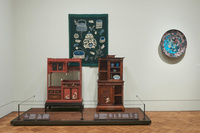
Despite my love of period rooms, I know all too little about furniture and porcelain, but the design of Gallery 251 seemed to anticipate this. Turning into the space, our attention is immediately drawn to the two ornate wood cabinets across the room (fig. 5). Both are clearly modern adaptations of traditional East Asian shapes, patterns, forms of decoration, and the combination of exquisite woods and costly inlays of various precious materials. And yet, these pieces are not simply, as one might easily assume, examples of European chinoiserie (broadly conceived). Rather, the left cabinet, made in Japan in the late 1800s, demonstrates what we might call a form of Asian Occidentalism, which reworks a common European furniture type through a deft application of Japanese lacquer. The result is stunning, and it seems hardly coincidental that the cabinet was produced with an eye for a Western consumer. Presented at the 1876 Centennial Exhibition in Philadelphia, it was purchased immediately by the city’s burgeoning museum of art. As one of its earliest acquisitions, the cabinet attests to the success of Japan’s efforts to promote the country’s decorative arts in the West. The French cabinetmaker Gabriel Viardot fell in love with what he saw and soon marketed himself as a creator of furniture “in the Chinese and Japanese style.” As is often the case, however, aesthetic infatuation with a foreign culture did not lead to deep respect for it as a whole. Thus, seeking inspiration in the art of other societies functioned all too often as a completely self-absorbed conduit to stoke one’s own imagination. The wall text rightfully points to this problematic side of aesthetic encounters:
Trade routes have connected China and Japan to Europe for many centuries, with art objects moving in both directions. In the 1800s, however, European countries and the United States used military pressure to coerce Japan and China into exploitative trade agreements, contributing to an unprecedented influx of East Asian art into European and American markets, exhibitions, and collections. . . .While European artists admired the art from Japan and China, their artistic responses were often rooted in European fantasies of an imaginary Orient. Such artworks presented an inaccurate vision of Asian cultures as backward and quaint—one that left a lasting mark on European art and society.
These remarks are but one example of the balanced, informative, and exceptionally well-written wall texts that accompany the reinstallation and communicate complex issues in a clear yet not overly simplified fashion. They allow the museum to address the more unsavory aspects of European culture particularly in regards to gender, class, and race, without, however, dismissing the aesthetic power of the art on display. Vidot’s eye-popping cabinet includes, as a support to a shelf, a bronze crane perched on a rather annoyed turtle. The motif is charming, yet the wall text reminds us of the colonialist underpinnings of such an appropriation of Indochinese motifs (fig. 6). At the same time, Viardot’s cabinet is displayed next to a Japanese one, inviting viewers to move back and forth between them to discover similarities and differences. The adjacent vitrines continue such cross-cultural juxtapositions with colorful porcelain vases. If I have one critique of Gallery 251, it is the lack of a homier feel; while the objects themselves invite a close-up encounter, they seem somewhat forlorn when seen from afar. The absolutely charming integration of historic wallpapers in Galleries 254 and 258, or the combination of furniture, objets d’art, and posters in Gallery 262 (fig. 7), show what can be done to maximize the aesthetic presence of things we usually like best when in use. However, we should not leave without mentioning a final bold choice: the inclusion of one of Claude Monet’s famous renditions of the Japanese footbridge he had added to his garden in Giverny, together with a waterlily pond, after seeing the Japanese gardens at the 1889 World’s Fair in Paris.
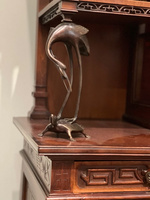
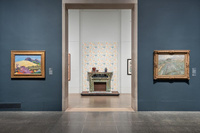
Monet also forms the perfect transition to the adjacent room dedicated to impressionism (Gallery 252). We are all familiar with the magnetism of this school’s pure, unmixed colors, visible brushstrokes, and roughly sculpted surfaces, as well as the appeal of its turn away from academic subject matter. Audiences love this art, which might be the reason why the map of the museum’s galleries on its website adds “Impressionism” as the only stylistic marker to its more general caption “European Art 1800–1850.” Popularity, however, has its own pitfalls. What once outraged critics and large parts of the Salon audience has turned into the fashionable mainstream. Whatever provocations this art may have once possessed have now been lost, as it now dominates the decoration of giftshop offerings, ubiquitous on greeting cards and cookie boxes, umbrellas and scarves, posters and canvas-prints. This raises an almost insurmountable hurdle to appreciating impressionism’s original boldness. The uncritical popularity of these pastel-colored meadows and dazzling coastlines, the knowledge that they functioned as sorts of historical amuses-gueules to the appetite for kitsch that would follow, incites ennui. Thus, it is no small feat to show impressionism in a fresh way, and this is exactly what this reinstallation has achieved. Stepping into the gallery after our “Complex Encounters,” we are welcomed by Marie van Goethem (as my daughter, justly insisting on the fourteen-year-old’s proper name, calls Edgar Degas’s famous dancer). She stands, ever in perfect posture, facing to the left. In the background, down the long vista to Gallery 259, her stare is matched by the no less imposing profile of Baron Oscar de Mesnil, modelled in clay and cast in bronze by Vincenzo Gemito in 1885 (fig. 8). But back to Marie. Although her portrait was modelled a few years earlier, between 1878 and 1881, the Adrien Hébrard foundry generated the Philadelphia version only in 1922. When my daughter greeted her favorite sculpture after her long absence during the renovations, she was very disappointed to find her now under glass. Yet, the decision to encase the figure not only answers to concerns about the fragile nature of its still original tulle tutu; it also reenacts the way Degas, worried about the delicacy of its wax medium, first showed his statue in such a protective fashion. Then, passing the aloof ballerina, we turn to the left and face a wall that takes our breath away as we admire four of Édouard Manet’s captivating seascapes (fig. 9). If you ever wonder why Manet is considered one of the era’s most groundbreaking artists, go no further. His daring translation of the sea’s constant flux into broadly brushed paintings captivates our imagination and satisfies both our yearning for narratives and the modernist fascination with art that asserts its existence as pure surface (fig. 10).
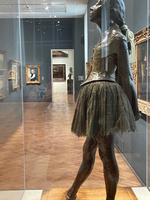
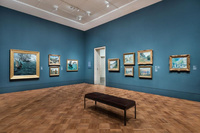
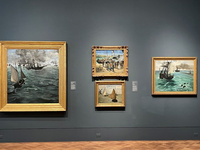
To the left, the largest of the canvases, Manet’s rendition of an American naval battle fought off the coast of France, near Cherbourg, on June 19, 1864, translates the latest sensational news into a gripping drama of modern marine warfare. As we are carried into the scene by the red-cross boat in the foreground, our gaze soon is swept away by the picture’s dynamism to the right, where a steamboat and a sailing ship, painted in 1868 after a trip to Bologne, take off to the left. The installation transforms the two oils, similar in color scheme, into unexpected pendants, not least because their various vessels now seem to be moving towards each other. Juxtaposing war and peace, they illustrate the passage of time as the steamboat is about to take over the sea, predicting a future when sail boats will be mostly relegated to leisure. Yet nostalgia is not Manet’s business, and the two small-scale pictures in the middle, one atop the other, grapple with very distinct aspects of modern life. The depiction of the steam ferry from Boulogne to Folkestone, the harbor’s counterpart across the Channel, vibrates with the bustle of international travel, the thick and sometimes choppy brushstrokes beaming with the tourists’ excitement and Manet’s visual interest. His signature indicates that he deemed the picture, painted sometime between 1868 and 1872, complete, despite a noteworthy lack of incidental detail. The happy, prattling confusion of the early days of the steamboat’s operation finds a counterpoint in the almost mathematical precision of Marine in Holland (1872). Together, the thought-provoking pairing of the four canvases highlights the breadth of Manet’s technical experiments but also his deep-rooted interest in tradition, and the dolphins frolicking in the picture to the very right not coincidentally cite a motif popular in ancient art. In our obsession with avant-garde invocations of tabula rasa, we often forget that modernists like Manet yearned for academic accolades. In his own eyes, he was less a revolutionary than a reformer, somebody who could imbue new life into worn-out traditions. His marine paintings certainly revived a well-established genre that had, however, become stale and tired.
Across the hallway, another stimulating juxtaposition in Gallery 255 asserts the past as a nourishing resource for inspiring innovation (fig. 11). A jovial Le Bon Bock (1873) appears here together with Arnold Böcklin’s self-absorbed Sappho (1862) and a couple of boisterous women from Seville observed by Mary Stevenson Cassatt in 1873. The label leaves no doubt about Manet’s debt to seventeenth-century Dutch genre painting, from the casual motif of a man enjoying his springtime Bock beer to the portrait’s warm tonalities and his lively handling of paint, which, as an image on the label demonstrates, recalls the work of Frans Hals. The three canvases are just another example of the freshness of Thompson’s combinatory logic. Manet’s vivacious alla prima technique is hardly a common choice to accompany Böcklin’s enigmatic symbolism or Cassatt’s boisterous indulgence in the fad for Spanish folklore, which itself exemplifies the practice of many impressionists to modernize traditional motifs. Yet put together, we realize that academic art itself wasn’t as boring (or worn-out) as is often suggested. Böcklin’s revamping of mythological history painting, for example, injects irreverent humor into the ancient stories. Fascinated with nature spirits rather than the Olympians, the German painter turns the Greek pantheon of gods upside down; mythology becomes strangely modern, as his satyrs and nymphs are caught up in the plight of modern relationships and marital strife, which leaves them, as in the large oil on the adjacent walls, decidedly distant and speechless in their post-coital state (fig. 12).
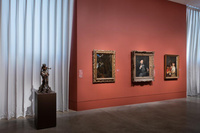
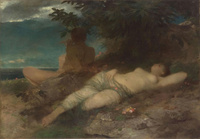
Gallery 255 is my favorite, if only for the fact that, of all the galleries, it unites diverse examples of nineteenth-century taste in the most unexpected ways. It exemplifies the rethinking at work throughout the galleries, so evident in the juxtapositions of work offered by the hang. Of course, this is the ultimate challenge of any reinstallation, and I would say that the Philadelphia Museum has succeeded in a quiet revolution (fig. 13). Who would have thought that Pierre Puvis de Chavanne’s 1879 Legendary Saints of France—with its flattened figures forming an ornamental band of pastel colors against a gleaming, patterned gold background—would be a perfect match for the peasant girl carrying two buckets of water up Jacob Maris’s 1872 Bridge at Loosduinen, her physical strain and unwavering determination played down by the tranquil light of a glowing yet overcast sky and its shimmering mirror image in the river below? And who would have thought that both would make such apt companions to Lawrence Alma-Tadema’s excitedly gesturing young poet of 1885, who, in a most unclassical depiction of classical Greece, reads Homer to a group of enraptured youth? But the display not only works but is most stimulating, and the same is true for the equally surprising pairing of Eduard Charlemont’s 1878 Moorish Chief, my most guilty pleasure of Orientalist fantasy, with the colorful depictions of contemporary leisure in Guiseppe de Nittis’s 1875 Return from the Races and Giovanni Boldini’s 1873 Highway of Combes-la-Ville (fig. 14). The light-filled pastel colors of these last two canvases bring out the love for materials and surfaces that draw the viewer so ferociously into Charlemont’s dark, mysterious interior, while highlighting the contemporaneity of the public’s penchant for scenes from modern life and its fascination with the exotic other. The fact that the placement makes the two pathways in the adjoining landscapes seem to move toward each other accentuates the wall’s visual soundness and sense of purpose.
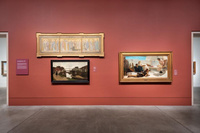
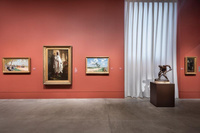
An equally captivating wall (fig. 15) displays the triad of Anton Mauve’s Return of the Flock, Larens (1887), Jozef Israëls’s The Last Breath (1872), and Henri Jean Augustin Leys’s Faust and Marguerite (1856). The closely hung trio suggest the complexity of the Realist movement. Where Israëls’s emotional depiction of the cycle of work and death in the villages of Holland evokes our empathy with the difficult life of fisherfolk, Leys’s propels us into a medieval past and the world of theater (fig. 16). Despite the literary gesture toward one of Johann Wolfgang von Goethe’s most famous plays, his 1808 Faust, the Belgian’s panorama of medieval Antwerp served a higher purpose than cinematic entertainment or a quaint exercise in escapism. His historicism pursued a decidedly contemporary agenda: to fashion a genuinely modern (which in Leys’s case also meant a genuinely democratic) style from the idiom of the historical epoch it set out to recreate, an attempt symptomatic of the period’s widespread belief in period style as the essential expression of the spirit of an age. To that end, antiquarian precision served as a conduit for a rare union of historical content and a historicist vocabulary—here an accurate representation of Renaissance architecture (namely Antwerp’s picturesque Chapel of Grace, which, completed in 1493, would fall prey to the city’s urban transformation in 1882); there an emulation of the primitivism of Northern Renaissance art. Accordingly, and in sharp contrast to most historicist renditions, Leys’s version of the past presents a bold parade of quintessentially medieval physiognomies, of faces plucked from the paintings of a Jan van Eyck, a Holbein, a Cranach. For once, we do not see contemporaries dressed up in medieval garb, but types whose very bodies look of the past. Even a quick glance at Thomas Couture’s 1843 Troubadour on the opposite wall shows how radical this departure from established practice was (fig. 17). Although no less pleasing than Leys’s Middle Ages, Couture envisions his Renaissance as a role-play of contemporary models dressed up in period costume. In sum, the compilation of various realisms in tightly curated spaces and multitiered arrangement opens up new insights into the workings of each individual piece. And precisely by comparing and contrasting do we reach a deeper understanding of the different kind of appeal each approach has and has for its own reasons. Sheep, I might add, have never looked better than presented from this perspective!
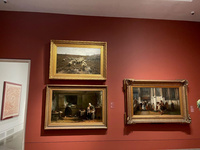
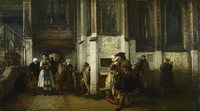
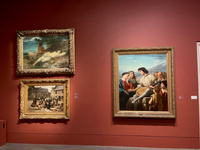
Gallery 255 may demonstrate that academic art was not that academic after all. Or at least not in the selection here offered. In this context, we must at least quickly mention John Graver Johnson (1841–1917), the eminent Philadelphia lawyer, generous patron, and avid collector of the art of his own time (as well as early Renaissance Italian and Dutch paintings which grace the third floor). Without Johnson, the collection wouldn’t be what it is. In the late 1870s he began buying pieces by living artists, as Gallery 253 (fig. 18), entitled “Painting Nature,” showcases, by exploring the growing appeal of yet another form of Realism (exemplified here by key figures like Rosa Bonheur, Gustave Courbet, or Jean-François Millet), the collector’s astute eye for contemporary art. The works gathered in this and adjacent rooms demonstrate Johnson’s adventurous taste as well as his role in the formation of other Philadelphia collections, including those of W. P. Wilstach, William L. Elkins, and P. A. B. Widener.
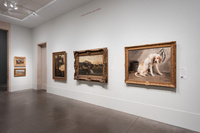
Tracing the effects of French impressionism throughout Europe, Gallery 259 mounts such incongruous works as the enigmatic, wall-spanning mermaid by the Norwegian Edvard Munch (1896), which, hovering seductively above a playful scene of Boys on a Log (Albert G. A. Edelfelt, 1884) and Jean-Charles Gazin’s Solitude (1889), forms a stark contrast to the essays on class delivered by Peter Severin Krøyer’s Interior of a Tavern (1886), where a group of peasants is enjoying an early-evening drink, and Viggo Johansen’s 1887 gathering of his bourgeois friends in a luxurious candle-lit living room (fig. 19). The display’s somewhat crowded mixture of paintings and sculptures evokes the mermaid’s original setting in a private Norwegian residence, and I was once again smitten by this fusion of modern curation with reflection on the taste of the past. If the gallery’s title “Beyond Paris” involuntarily highlights our fixation on the French capital as the sun of an avant-garde universe, the gathering of Norwegian, Scandinavian, French, and US artists in this room is most delightful, and goes beyond a demonstration of how these artists adopted and adapted the color, light, and brushwork of impressionism. Uniting household names like John Singer Sargent, James Abbott McNeill Whistler, and Henry Ossawa Tanner with those less familiar to the general public like Frits Thaulow or Emilio Sánchez Perrier drives home how different locations served as sources of inspiration and influenced painters leading into the twentieth century. What is striking, here and elsewhere, is the way in which the multiplicity of expression is staged by creating coherent themes—in this gallery by the motif of water which, interspersed by a café scene and a stroll in the Jardin du Luxembourg, leads from the depopulated Water Mill (1892) of Thaulow to the joyful, life-enforcing beach scene of the Spanish artist Joaquín Sorolla y Bastida, whose young, exuberantly healthy-looking protagonists of 1903—aptly called The Young Amphibians (see fig. 19)—seem as elemental as the waves they are playing in. What a difference to the touching melancholy of Antonio Mancini’s adjacent 1879 Saltimbanco (fig. 20), a theme treated earlier by the Italian but now conceived on an unprecedented scale, probably in anticipation of its presentation at the prestigious Salon of the French Royal Academy in Paris. The artist invested his subject with an important secondary meaning, deriving the pose of the figure from traditional representations of Christ as “Ecce Homo” and the “Man of Sorrows.” Among the pictures of sociability is a figure from Hans Christian Anderson’s fairy tales, and Mancini’s young circus performer adds a somber religious note, which, drawing a parallel between the sufferings of Christ and of mankind, demonstrates that immediate, unmediated nature observation could still be a vessel for very different kinds of symbolic or political meaning.
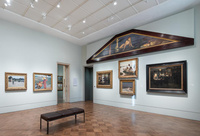
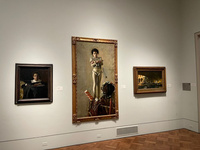
Sculptures are dispersed throughout the galleries. They include small bronzes of athletes and fragments of the human body by Auguste Rodin, displayed among the impressionists, and his fabulous and newly-acquired Vase of the Titans (modeled ca. 1878–80, cast 1890), a sculptural ceramic designed by Albert Carrier-Belleuse and exhibited in a gallery of academic art, for which he sculpted the four male figures whose twisting bodies struggle under the weight of the monumental vessel (fig. 21; see also fig. 11). Of special note is the captivating Pythian Sybil by star-sculptor Marcello (a pseudonym for the Duchesse of Castiglione-Colonna), fashioned in the late 1860s after her own body and with a keen eye for the figure’s trance-like state (fig. 22). There is what I would like to call a democratic sensibility at play in this exemplary reinstallation, which makes a concerted and successful effort to break down established hierarchies of genres (which favor painting and sculpture over the applied arts and design). It thus seems only logical that the sequence of rooms (notably Galleries 252, 258, and 262), which run alongside the galleries devoted to painting and sculpture of the late nineteenth century, explore the design revolutions occurring at the same time. And there is one other innovation to praise, which turns a rather difficult space into a true asset: Gallery 256 (fig. 23). Another intimately spaced room with a dome-shaped ceiling but no natural light, located in the hallway that leads straight from the entrance to the famous Resnick Gallery and Cezanne’s Large Bathers (1900–1906), is devoted to rotating displays of prints, drawings, and photographs. The space thus allows the curators to delve into the museum’s deep holdings of works on paper and connect nineteenth-century art with a wide variety of other moments and other locales in world art, from Japanese prints and seventeenth-century Dutch etchings to contemporary art. The decision to make space for another department, namely, that of Prints and Drawings, points to the collaborative spirit behind the reinstallation efforts and adds a sense of dynamism to the notion of a permanent exhibition.
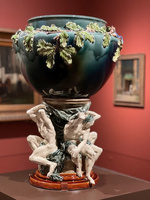
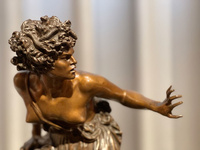
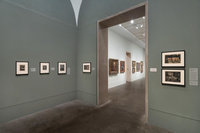
We cannot leave our exploration of the newly installed European galleries without talking about the passageway that leads from the inviting, spring-like atmosphere of the entry, past a ravishing array of Monet’s variations of trees (another most evocative line-up) and a gallery (Gallery 257) of “Experiments in Paint” (fig. 24), to the impressive Resnick rotunda (Gallery 261). Fully transformed by the new wall color, a deep blue-gray, the room invites us, with ample seating, to rest among a who’s who of postimpressionism (fig. 25). To group these highly individual painters under the word “post” is admittedly a bit odd, but if these artists did not share a single style, they embarked on a collective effort to create, just when impressionism matured in the late 1800s, more expressive, personally relevant art. Roger Fry struggled to find a suitable label and eventually came up with the vague but pragmatic “Post-Impressionism,” which still serves us well. The new, and quite restful, wall color allows the renowned collection of works by Vincent van Gogh, Henri de Toulouse-Lautrec, and Paul Gauguin to unfold their emotional potential to the fullest, as their bold, flat colors stand out against the dark background. The room color also intones a perfect counterpoint to the two adjacent rooms dedicated to Paul Cézanne that bracket the rotunda: the intimately scaled Gallery 260 (see fig. 26), devoted entirely to the Frenchman’s smaller works—a picture of fruit on a table, a study for the bathers, several portraits of his wife and scenes from secluded groves in Aix-en-Provence—and the spacious, shallow but high, Gallery 264 dominated by his Large Bathers of 1900–1906 (see fig. 25; see also Fig. 7).
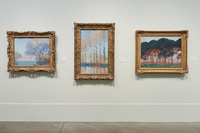
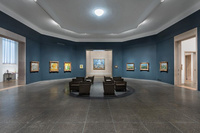
One could not stage Cézanne’s intense study of form, structure, and shape better than by orchestrating our approach to one of his largest and most famous canvases by setting up his small-scale works as a prelude. With the Large Bathers already in sight, Gallery 260 invites a close-up study of his distinctive brushstroke and his exploration of color and light to convey shapes and the solidity of forms (fig. 26). Uniting some of Cézanne’s most important works from the collection, the display forges a powerful bridge to the Large Bathers, which, drenched in natural light, forms the spectacular finale of this impressive enfilade. Any museum could be proud of such riches, and, together with the examples housed at the Barnes Foundation (now down the street), Cézanne’s work is perhaps nowhere better represented than in Philadelphia. But the reinstallation never relies simply on the prestige of the PMA’s collection. In this instance, the display moves from Cézanne’s obsession with the female nude in nature to show how he and others reimagined the subject. Thus, two life-size bronze statues by Aristide Maillol guard Cézanne’s grove, while works by Edgar Degas, Pierre-Auguste Renoir, and, surprisingly, Francis Picabia, surround it (fig. 27). If I have one regret, it is the absence of Léon Frédéric’s cascading river of Herculean babies, The Source of Life (1890), which has always baffled and intrigued me (fig. 28).
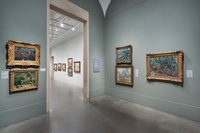
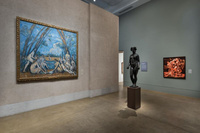
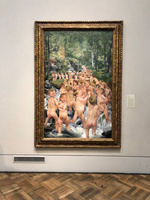
There is much more to say about the renovation and reinstallation of PMA’s holdings of European art between 1850 and 1900, but I leave it at this. Part of an ambitious, $196 million project which started in March 2017 to fundamentally revamp the museum’s internal logic (new galleries, new circulation paths, and 67,000 square feet of new public space), the scope of the renovations included not only the fresh wall colors but resurfacing the walls and refinishing floors as well as adding new casework, window treatments, and seating for visitors. Although most of the renovations were completed in 2019, with galleries gradually reopening between August 2019 and January 2020, the pandemic delayed finishing the remaining galleries until spring 2022. A particular challenge was posed by the need to retain access to the Modern and Contemporary galleries that follow the enfilades explored here. The curatorial team could only work on two to three galleries at a time, which resulted in a lengthy piecemeal approach. Knowing this makes the exhibition’s intellectual and visual coherence even more impressive. In short, perseverance has paid off, and it is time to give the curators their due: Jennifer Thompson (the Gloria and Jack Drosdick Curator of European Painting and Sculpture and Curator of the John G. Johnson Collection); Kathryn Hiesinger (the J. Mahlon Buck, Jr. Family Senior Curator of European Decorative Arts after 1700); Alisa Chiles (Assistant Curator of European Decorative Arts); Tara Contractor (Assistant Curator of European Painting); Colin Fanning (Assistant Curator of European Decorative Arts); Michelle Millar Fisher (Assistant Curator of European Decorative Arts); the Curatorial Fellows Olivier Hurstel, Miriam Stanton, and Genevieve Westerby, and, last but not least, Research and Exhibition Assistant Eileen Owens.
When I asked Jennifer Thompson about her main objectives, she immediately mentioned the dialogue among the decorative arts, paintings, and sculptures on view, which indeed makes the Philadelphia galleries so enticing to me. “The vignettes incorporating furniture, wallpaper, and ceramics are particularly effective in giving visitors a sense of context for the period and the design changes that occurred between 1850 and 1900,” Jennifer mused and added, “We were especially interested in presenting the second half of the nineteenth century as a dynamic and complex period with resonance and relevance today. A few of the changes about which I am most pleased are the integration of the Carroll S. Tyson Collection with the rest of the collection—this means we can now present our Van Gogh paintings side by side and show four Manet seascapes together.” I was pleased too, and not only about the Van Goghs and Manets. Stepping from the cold grandeur of the entrance hall into the newly minted European galleries we enter an exciting conversation between artists, artifacts, and art forms, and I, for my part, will return regularly to listen to its many voices.